The Sony Ericsson Xperia Play: Where Do You Want To Take Your Gaming Today?
by Brian Dipert on August 8, 2011 1:26 PM EST- Posted in
- Smartphones
- Sony
- Android
- Xperia Play
- Mobile
At Brian Klug's recommendation, I ran the Xperia Play through a battery of common benchmarking tests. Below you'll find the alphabetically ordered results, in comparison to similar-featured and similar-age Android handsets from other suppliers:
Basemark (aka 3DMarkMobile) ES 2.0 V1
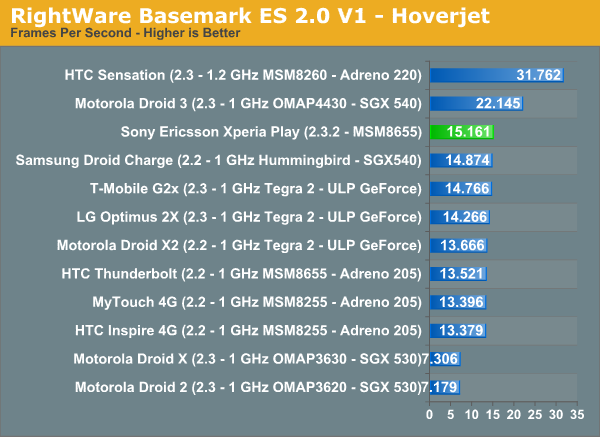
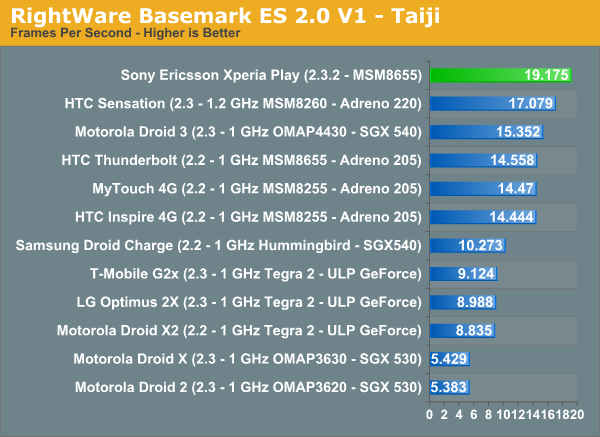
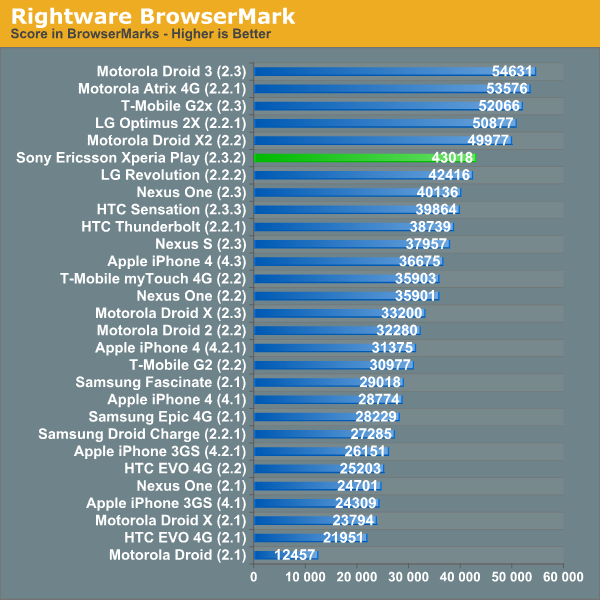
GLBenchmark 2.0 ('Standard' results in both cases)
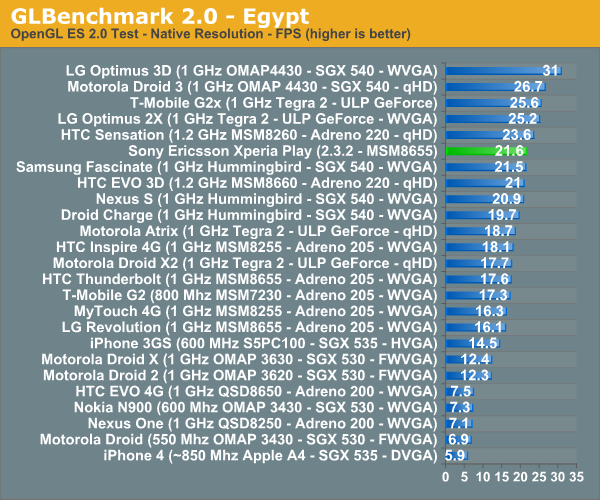

kwaak3 aka Quake 3 (note that this particular test was run with lightmaps off, per longstanding AnandTech practice)
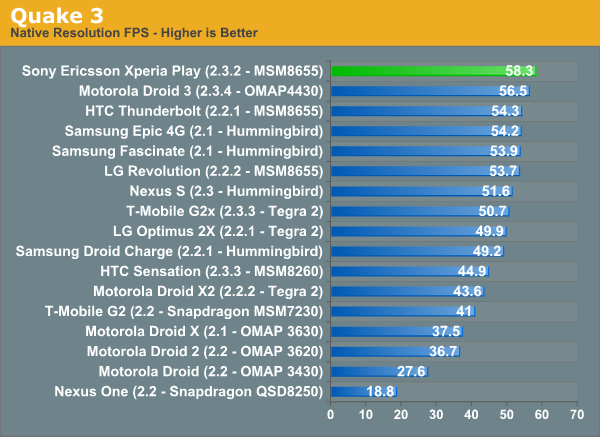
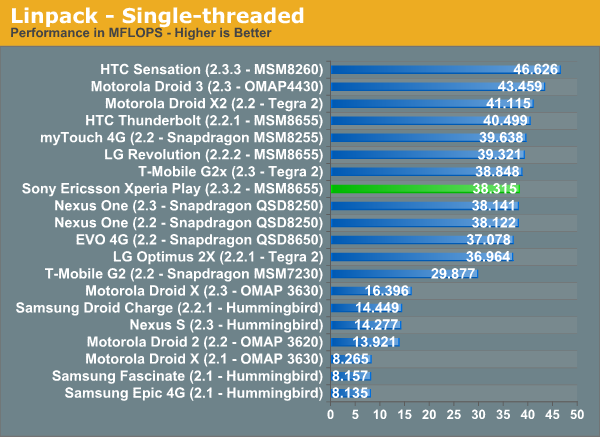
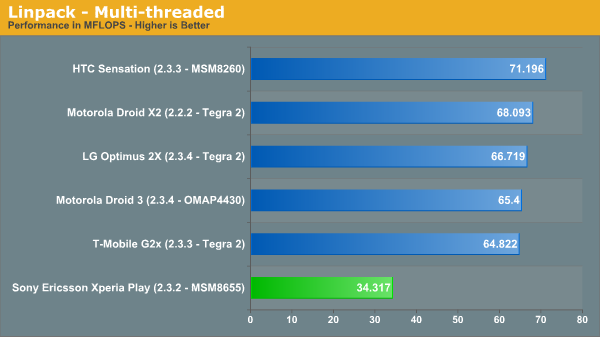
And SunSpider 0.9
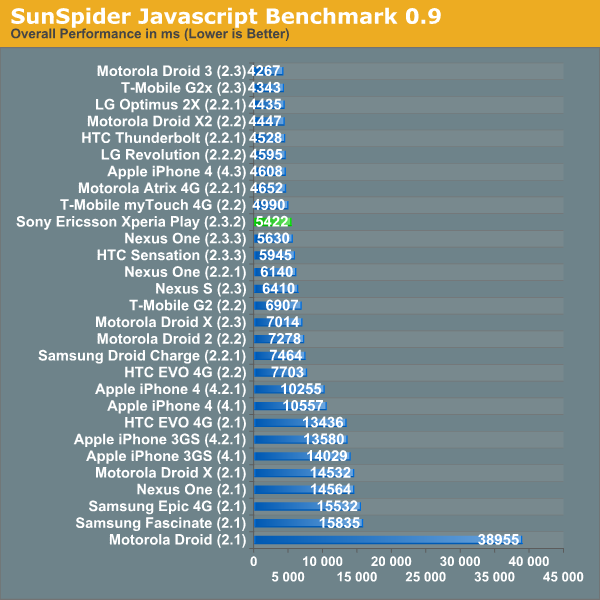
The results are largely predictable, but some encouraging surprises also emerged. Performance differences between platforms based on the first-generation 65 nm-based QSD8x50 (aka S1-class SoC) and second-generation 45 nm-based MSM8x50 SoCs predominantly derive from two factors, since the processor cores are fundamentally the same save for the process they're built on:
· Clock speed differences (800 MHz versus 1 GHz, for example), and
· Graphics core differences (Adreno 200 with the QSD8x50, Adreno 205 with the MSM8x55)
Slight variances between similarly clocked systems in CPU-centric benchmarks are likely the result of benchmark run-to-run differences, coupled with minor evolutionary Dalvik virtual machine enhancements in successive Android versions. Perhaps the most significant Dalvik improvement came with the transition to Android 2.2 'Froyo', which added a JIT (just-in-time) compiler to the mix with a resultant claimed 2x–5x performance boost with CPU-heavy code. The Xperia Play still notably outperforms its fellow MSM8x55- and Adreno 205-based peers on graphics-heavy benchmarks. This result surprised me, until Brian Klug explained that the Xperia Play represented one of the first production systems containing improved graphics drivers from Qualcomm.
Unlike with a PC, where you can regularly install updated drivers from AMD, Intel or Nvidia, with a handset you need to rely on Google and its hardware and carrier partners to bundle the updated drivers with an operating system upgrade for your hardware...or in this particular case, for an OEM like Sony Ericsson to include them from the get-go. Note, for example, the frame rate improvements of the Xperia Play on Basemark ES 2.0's 'Taiji' and Hoverjet tests, versus the seemingly identical (at least from CPU and GPU standpoints) HTC Thunderbolt. Similarly, the Xperia Play had notably higher frame rates in the Quake 3-based kwaak3 test, versus the Thunderbolt.
One other result was also intriguing, until I thought about it for a bit. Linpack recently added a multi-threaded benchmark option, so I decided to run both it and the legacy single-threaded test. The multi-threaded MFLOPs (millions of floating-point operations per second) was lower than that for the single-threaded test variant; consider, however, that the MSM8x55 is a single-core CPU. I believe that the decrease is the result of multi-thread management thread-switching latency overhead, in spite of the Cortex-A8 superscalar dual-issue microarchecture foundation upon which Qualcomm built its Scorpion approach. Conversely, if you look at the Linpack data for a system such as the HTC Sensation 4G, based on a true dual-core CPU such as Qualcomm's MSM8x60 (S3-class SoC), you'll see dramatically higher multi-threaded Linpack results in comparison to those for the traditional single-threaded test.
FYI I also tested the Xperia Play using Qualcomm's recently introduced Vellamo benchmarking suite, but AnandTech isn't quite ready yet to start publishing Vellamo results. Stay tuned for more in this regard. Similarly, I ran the Xperia Play through the newer SunSpider 0.9.1, whose results we'll start publishing once we have a sufficient-sized system sample set.










34 Comments
View All Comments
name99 - Tuesday, August 9, 2011 - link
"Yes, the silver trim is plastic, not metal, ... and minimized the potential for interference-induced antenna sensitivity degradation"Do we know that this is ACTUALLY true? Or is this high school EM applied completely inappropriately?
Obviously it is true that have metal parts in a phone affects the antenna. It's just as true that
- most phones (from a whole range of manufacturers) ship with large chunks of metal in them
- Apple's portables (those with which I am most familiar) went through a phase some years ago where the plastic MacBooks had better reception than the metal MacBook pros, but that hasn't been the case for a while. And the limited knowledge I have of Win portables (or various tablets) doesn't have people all stating unanimously "buy xxx [with a plastic cover] because its radio reception is so much better than yyy [covered with magnesium or titanium or aluminum or whatever]".
I don't have a strong opinion about this either way, but it seems to me, based on behavior across a range of manufacturers that the true state of affairs is
- if you're an amateur then using plastic is probably best because you can just ignore it BUT
- if you're a professional (and pretty much every company of interest IS now professional] you just model the entire environment (metals plus dielectrics) as finite elements. optimize the antenna for that environment, and things works out as well as they realistically can.
[And, OMG, please, if you're a commenter who feels the need to pipe up about "antenna-gate" and "grips of death", ask yourself before you comment:
- does my comment add anything useful to the question that has been posed? AND
- does my comment make me look like a retarded 14yr old with poor impulse control?]
medi01 - Wednesday, August 10, 2011 - link
I worked in EM field, and what you state is utter nonsense.You can repeat "I'm a professional, very professional, superprofessional" all day long, with "it's magical, it's very very magical" on top of it, but it still won't help you to get EM waves through the metal.
Surrept - Tuesday, August 9, 2011 - link
Is this the Brian Klug that was once bitten by a fox. It only makes sense he is on the staff here. Smartest person i've ever met in the field of computers.